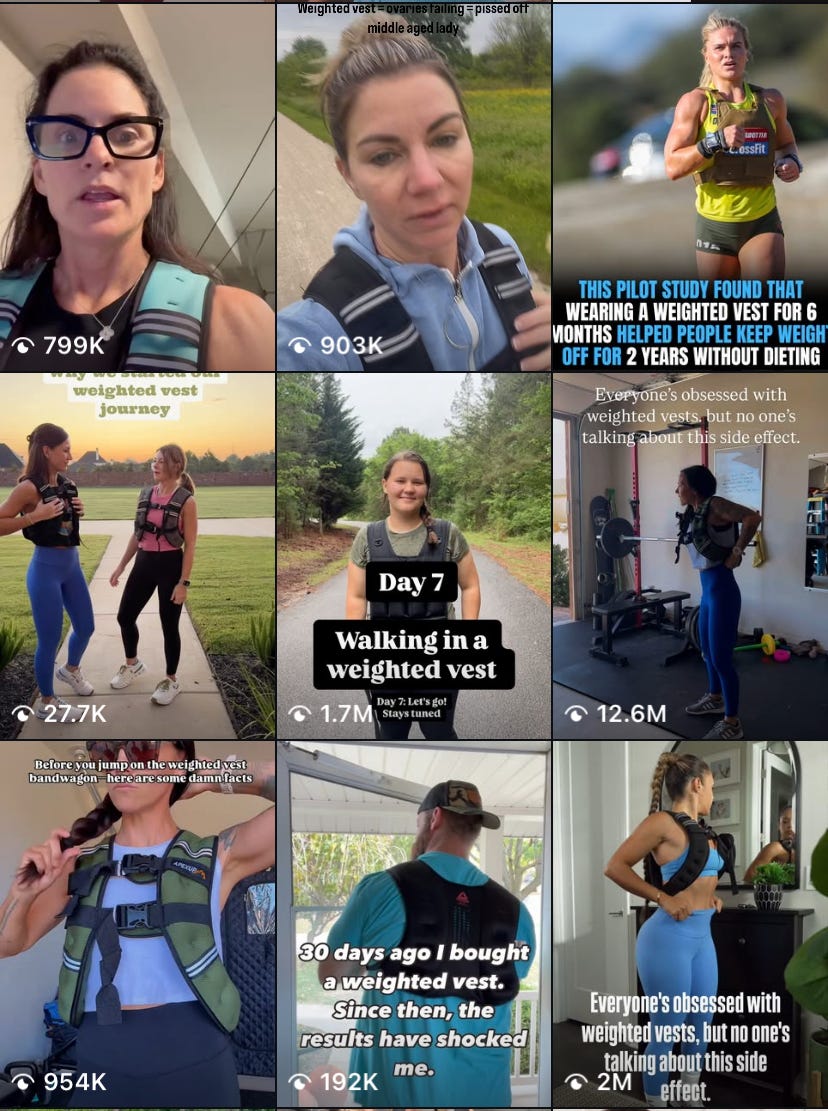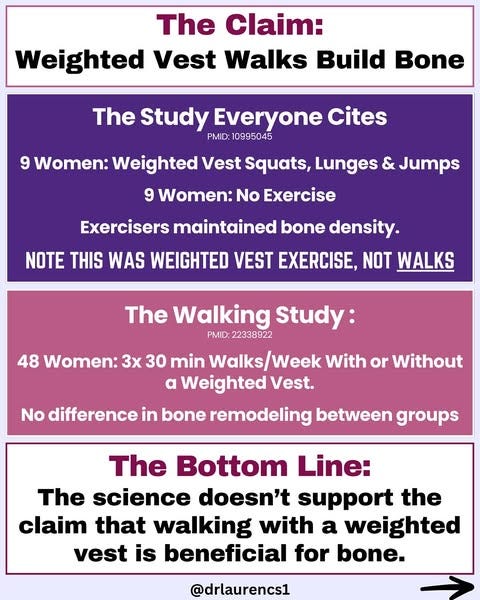Ugh, I have to do a whole weighted vest thing, don’t I.
Is the latest perimenopause trend worth the hype?
I was out for drinks and tater tots with friends on Wednesday night, and talk turned to perimenopause. Talk always seems to turn to perimenopause lately, and that was actually exactly what we were discussing. “It feels like I haven’t had a single conversation with other women lately where it didn’t come up,” my friend Mollie said. And, sure, we’re all closer to the life stage in question than we were a few years ago, but you have to admit, it’s really in the air right now. This is, in many ways, a good thing! We now have more research that shows HRT can be a safe and effective treatment for many people; it’s way, way, way more acceptable to talk about the experience (which we all know makes things more manageable); and there are lots more resources out there to learn about perimenopause and how to care for yourself through this period of life.
But: It’s also very much an industry, and given the explosion in interest, and the sudden willingness everyone has to talk about it, we’re also being inundated with products and services supposedly designed to address peri–related issues (or issues that are ostensibly related to perimenopause, anyway). I’m sure plenty of these products are great! But man, there’s a lot of noise.
’s recent interview with Cole Kazdin went into some of this in depth:And I can only imagine that this — the cha-ching factor; those sweet, sweet affiliate bucks — is a big part of where the current weighted vest trend came from. I’ve gotten a lot of questions about these lately, so let’s talk about ‘em.
Weighted vests have been around for a long time; they’ve been used in military training and in certain CrossFit workouts. Murph, the CrossFit workout traditionally done on Memorial Day in memory of a U.S. Navy SEAL who died in Afghanistan, is probably the most famous one: you run and do about a trillion pull-ups, push-ups, and squats, all while wearing a weighted vest. (I’ve done Murph, but only sans weighted vest, and heavily scaled back, and it’s still absolute hell!!!!! But also weirdly fun!) The idea is that training while carrying additional weight on your person helps improve endurance and stamina, which may be true, depending on the training conditions. (A lot of the research around this is pretty old, but you can find some reasonable studies cited in this study from the Journal of Strength and Conditioning Research.)
What’s less clear is whether the current hype around weighted vests and the musculoskeletal effects of aging — namely, a decline in muscle mass and bone mineral density — actually holds water. (And, for what it’s worth, I am saying “aging” here and not menopause: There is some debate over whether these declines are actually linked to the hormonal changes of menopause or if they’re simply the natural result of aging. That feels like a whole other post!) The muscle physiology researcher Lauren Colenso-Semple, PhD, who is great on Instagram (though, fair warning, does talk about weight and fat loss — though from a scientific, evidence-focused perspective, not a promotional perspective) recently did a couple of great posts debunking the popular claims about weighted vests and menopause, so let’s take a look at this one, about bone density:
Basically: People like to cite a study that supposedly suggests walking with a weighted vest can improve bone mineral density. But in reality, a study comparing women who walked with a weighted vest three times a week and those who walked without a weighted vest found no difference in bone remodeling between the two groups. Another weighted vest study did find that the vest group maintained bone density while the other group did not — but the vest group was wearing them while doing squats, lunges, and jumping! The other group wasn’t doing this special programming.
Dr. Colenso-Semple was also interviewed in this helpful New York Times article about weighted vests, and on the “do weighted vests help you build muscle mass” point, succinctly said, “It’s not a trade for traditional full-body resistance training.”
So what’s the bottom line? There are a lot of people out there right now who are looking to sell you menopause-related products. And as these things go, weighted vests are relatively low-risk! If you start too heavy (or use a pack that doesn’t fit you well), you’ll probably end up with a pretty sore neck and back, so do take it slow if you want to try it. If you enjoy it and feel great wearing it, you absolutely don’t need to stop. You may notice that your daily activities feel a little easier when you take it off because you’ve built a bit more stamina and endurance from wearing it around. (If you’ve ever done babywearing, you know the drill here. You take that heavy-ass baby off and feel utterly lighter than air!) Maybe your cardiovascular health improves a little, too. Another interesting study found that while walking with a weighted vest didn’t appear to improve bone mineral density compared to walking sans vest, the vest group experienced improved balance, which is great.
But is wearing a weighted vest while walking around or exercising the secret to preventing musculoskeletal aging? Probably not. We know what helps: Staying active. Resistance training, and specifically progressive overload and lifting close to failure on a regular basis. Weight-bearing exercise, like walking, running, or dancing. Getting enough calcium and vitamin D. Not smoking, and not drinking too much. You can do all of these things with a weighted vest on if you want to! But you don’t need to, and it may not make all that much of a difference.
(And of course, your evergreen reminder that health is not a moral obligation. If you have osteoporosis or another MSK condition, or if you aren’t engaging or can’t engage in the lifestyle habits that are good for your bones and muscles, it’s okay! You’re still a worthy person. Don’t let all this optimization stuff get you down, please.)
Here’s one thing I will say for the weighted vest hype crew: I personally haven’t seen a ton about its powers as a tool for weight loss or fat loss. The hype is really mostly around the functional musculoskeletal issues that do legitimately merit some of our focus as we age. It kind of feels like a teeny bit of progress that, even if a product won’t do exactly what it says it will, it isn’t being sold primarily as a weight loss tool. (Though, for what it’s worth, there apparently are claims out there about fat loss, which are also pretty handily debunkable.) But still, wildly overhyped and misinterpreted data being used to sell you a product you don’t need is not great, no matter the supposed reasoning.
Anyway: I’m definitely not here to rain on anyone’s weighted vest parade. Again, if you love it, and it motivates you to be active and feel great, please don’t let me stop you — it’s probably not harming you and may even be helping improve your athleticism in certain ways. But as far as I can tell, if you aren’t already marching in that particular parade, you don’t need to feel any pressure to join in on account of any worries about aging, bone density, and muscle mass.
Let me know what questions or thoughts you have. Do you have a weighted vest and love it? I’d love to know!
xo
Anna









I'm fat. I do the equivalent of wearing a weighted vest every day. Does it make my bones stronger? 🤷♀️
I saw a woman in mirrored sunglasses and a vest angrily stomping down the street and from a distance, I swear, I thought: Is it ICE coming for my neighbors or is it a perimenopausal woman?